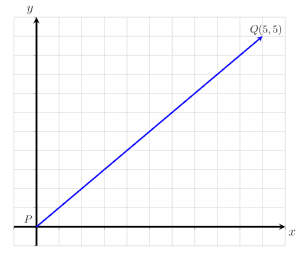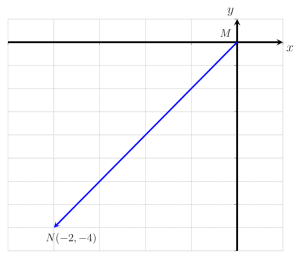- Home
- >
- Vector Magnitude – Explanation & Examples
JUMP TO TOPIC
Vector Magnitude – Explanation & Examples
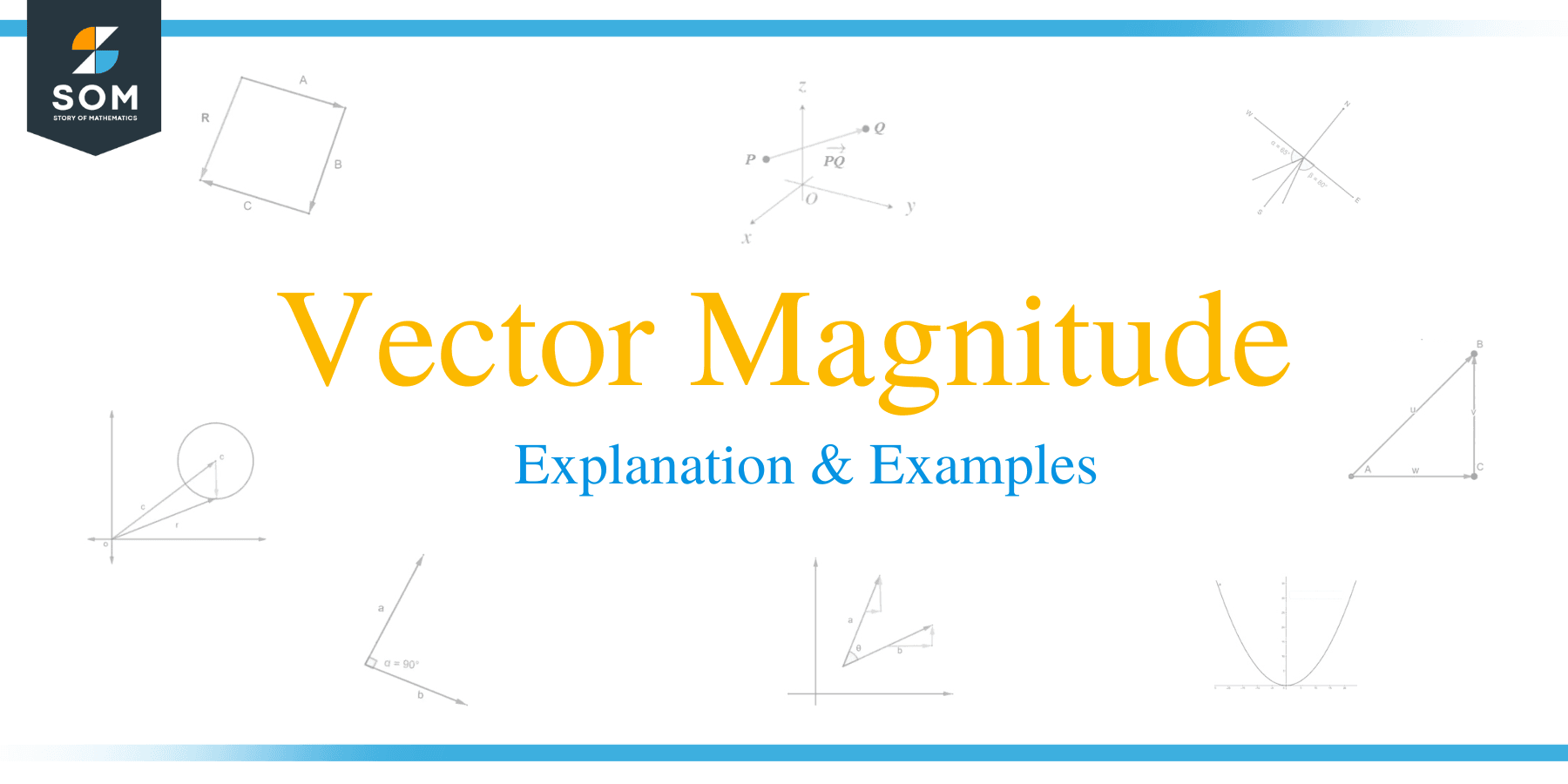 We already know that the two parts of a vector are vector magnitude and vector direction. What can we learn about a vector from its magnitude?
We already know that the two parts of a vector are vector magnitude and vector direction. What can we learn about a vector from its magnitude?
Vector magnitude is the length or size of the vector.
In this topic, we will discuss the following aspects of vector magnitude:
- What is the Magnitude of a Vector?
- The Magnitude of a Vector Formula
- How to Find the Magnitude of a Vector?
What is the Magnitude of a Vector?
In physics and mathematics, the magnitude of a vector can be defined as:
“The length of a vector or the distance between the initial point and the endpoint of a vector.”
The magnitude of a vector A is written as |A|. If AB is a vector that starts from point A and ends at point B, its magnitude can be represented as |AB|.
Recall that vectors can also be written as a pair of coordinates, and we call this representation a column vector. For example, the vector A = (x1,y1) is a column vector. This vector would be modeled in the Cartesian coordinate system as a line segment extending from (0,0) to (x1, y1) with an arrow at the end, as shown below. In this example, the magnitude, |A|, of the vector A is the line segment’s length.
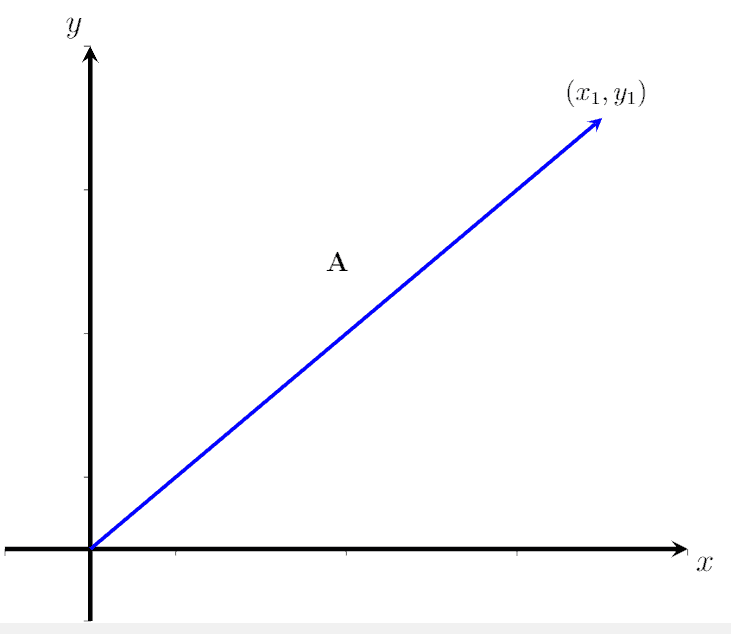
The Magnitude of a Vector Formula
In this section, we will learn the mathematical formulas used to determine the magnitude of a vector in various dimensions.
- The Magnitude of a Vector in Two Dimensions
- The Magnitude of a Vector in Three Dimensions
- The Magnitude of a Vector Formula for n Dimensions
- The Magnitude of a Vector using the Distance Formula
The Magnitude of a Vector in Two Dimensions
To determine the magnitude of a two-dimensional vector from its coordinates, we will take the square root of the sum of the square of each of its components. For example, the formula to compute the magnitude of a vector U = (x1, y1) is:
|U| = √x1^2 + y1^2
This formula is derived from the Pythagorean theorem.
The Magnitude of a Vector in Three Dimensions
To determine the magnitude of a three-dimensional vector from its coordinates, we will take the square root of the sum of the square of each of its components. The formula for the magnitude of a vector V = (x1, y1, z1) is:
|V| = √x1^2 + y1^2 + z1^2
The Magnitude of a Vector Formula for n Dimensions
For an arbitrary n-dimensional vector, the magnitude’s formula is similar to the formula used in the two and three-dimensional cases.
Let A = (a1, a2, a3 ……., an) be an arbitrary n-dimensional vector. Its magnitude is:
|A| = √a1^2 + a2^2 + a3^2+ …. + an^2
Thus, using these formulas we can easily determine the magnitude of any vector in any dimension.
The Magnitude of a Vector using the Distance Formula
Since the vector MN‘s magnitude is the distance between its initial point, M, and the endpoint, N, its magnitude is denoted as |MN|. If M = (x1, y1) and N = (x2, y2), we can determine its magnitude using the distance formula as follows:
|MN| = √(x2-x1)^2 + (y2-y1)^2
To use the above formula, we first take the x-coordinate of the endpoint and subtract the x-coordinate of the starting point. Then, we square the resulting value. Similarly, we subtract the y-coordinate of the starting point from the y- coordinate of the ending point and square the resulting value.
Finally, we add these squared values together and take the square root. This will give us the magnitude of the vector.
How to Find the Magnitude of a Vector?
In this section, we will practice computing the magnitudes of different vectors.
Examples:
These examples include step-by-step solutions to build a better understanding of calculating vector magnitude.
Example 1
Express the given vector AD as shown in the image below as a column vector and determine its magnitude.
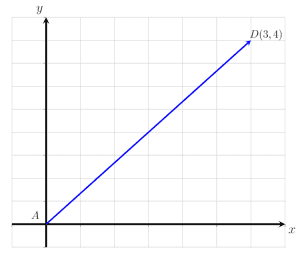
Solution
By definition, a column vector can be expressed as an ordered pair. From the above image, it can be seen that the vector AD starts at point A and ends at point D. It is displaced 3 points to the right along the x-axis and 4 points upward along the y-axis.
Thus, the given vector AD can be expressed as the column vector:
AD = (3,4)
The magnitude of the given vector can be found using the magnitude formula for the two- dimensional vectors:
|AD| = √ 3^2 + 4^2
|AD| = √ 9+16
|AD| = √ 25
|AD| = 5
Thus, the magnitude, or length, of the vector AD is 5 units.
Example 2
Express the given vector UV as shown in the image below as a column vector and determine its magnitude.
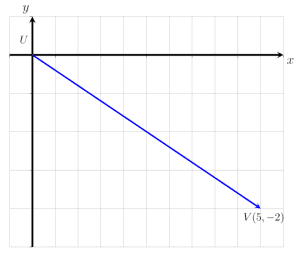
Solution
By definition, a column vector can be expressed as an ordered pair. From the above image, it can be seen that the vector UV starts at point U and ends at point V. It is displaced 3 points to the right along the x-axis and 2 points downwards along the y-axis.
Thus, the given vector UV can be expressed as the column vector:
UV = (5, -2)
Note: The -2 indicates that the vector is displaced downwards along the y-axis.
The magnitude of the given vector can be found using the magnitude formula for the two- dimensional vectors:
|UV| = √ 5^2 + (-2)^2
|UV| = √ 25 + 4
|UV| = √ 29
Thus, the magnitude, or length, of the vector UV is √ 29 units.
Example 3
Determine the magnitude of vector V = (4,-4,-2).
Solution
The given vector is a three-dimensional vector, and its magnitude can be computed using the three-dimensional magnitude formula:
|V| = √ 4^2 + (-4)^2 + (-2)^2
|V| = √ 16 + 16 + 4
|V| = √ 36
|V| = 6 units
Thus, the magnitude of the three-dimensional vector V is 6 units.
Example 4
Determine the magnitude of vector OW, the initial point of which is O = (2,5) and the final point is W = (5,2).
Solution
We can use the distance formula to determine the magnitude of the given vector OW:
|OW| = √ (5-2)^2 + (2-5)^2
The above formula can be simplified as:
|OW| = √ (3)^2 + (-3)^2
|OW| = √ 9 + 9
|OW| = √ 18
|OW| = √ 2*9
|OW| = √ 2*(3)^2
|OW| = 3 √ 2 units
Thus, the magnitude of vector OW is approximately 4.242 units.
Example 5
Determine the magnitude of the vector PQ, the initial point of which is P = (-4, 2) and the final point is Q = (3,6).
Solution
We can use the distance formula to determine the magnitude of the given vector PQ:
|PQ| = √ (3-(-4))^2 + (6-2)^2
The above formula can be simplified as:
|PQ| = √ (7)^2 + (4)^2
|PQ| = √ 49 + 16
|PQ| = √ 65 units
Thus, the magnitude of vector PQ is approximately 8.062 units.
Example 6
Determine the magnitude of the vector AB, the initial point of which is A = (3, 2,0) and the final point is B = (0,5, 3).
Solution
We can use the distance formula to determine the magnitude of the given vector AB:
|AB| = √ (0-3)^2 + (5-2)^2 + (3-0)^2
The above formula is simplified as:
|AB| = √ (-3)^2 + (3)^2 +(3)^2
|AB| = √ 9 + 9 + 9
|AB| = √ 27
|AB| = √ 3*9
|AB| = 3 √ 3
Thus, the magnitude of vector AB is approximately 5.196 units.
Practice Questions
Determine the magnitude of the following vectors:
- X = 20m, North
- A = (-1, -2/3)
- F = (4, 10)
- V = (2, 5, 3)
- T = (0, 2, -1)
- CD = (3, 2, 5)
- Vector OA whose starting point is at O = (-1,0, 3) and ending point is A = (5,2,0)
- UV, where U = (1, -2) and V = (-2,2)
- Express the given vector PQ in the image below as a column vector and determine its magnitude.

- Express the given vector MN as shown in the image below as a column vector and determine its magnitude.

- Compute the magnitude of the vector XZ in the image below where X = (0,1) and Z = (3,6).
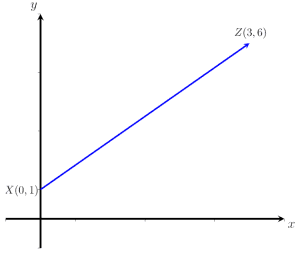
Answers
- The magnitude of the given vector is |X| = 2m.
- The magnitude of the given vector A is |A| =√ 13/9 units.
- Magnitude is |F| = √ 116 units
- The magnitude of the given vector is |V| = √ 38 units.
- The magnitude of the vector T is |T| = √ 5 units.
- The magnitude of the given vector is |CD| = √ 38 units.
- Magnitude is |A|= 7 units.
- The magnitude of the given vector is |UV| = √ 29 units.
- The vector PQ can be expressed as the column vector:
PQ = (5,5)
That is, the vector PQ starts at the point P and ends at the point Q. It is translated 5 points to the right along the horizontal axis and 5 points upward. The magnitude of the vector PQ is|PQ| = √ 50 units.
- The vector MN can be expressed as the column vector:
MN = (-2, -4)
This means that vector MN starts at point M and ends at point N. It is translated 2 points to the left along the horizontal axis and 4 points downwards along the y-axis. The magnitude of the vector MN is |MN| = √ 20 units.
- The magnitude of the vector XZ is |XZ| = √ 45 units.

